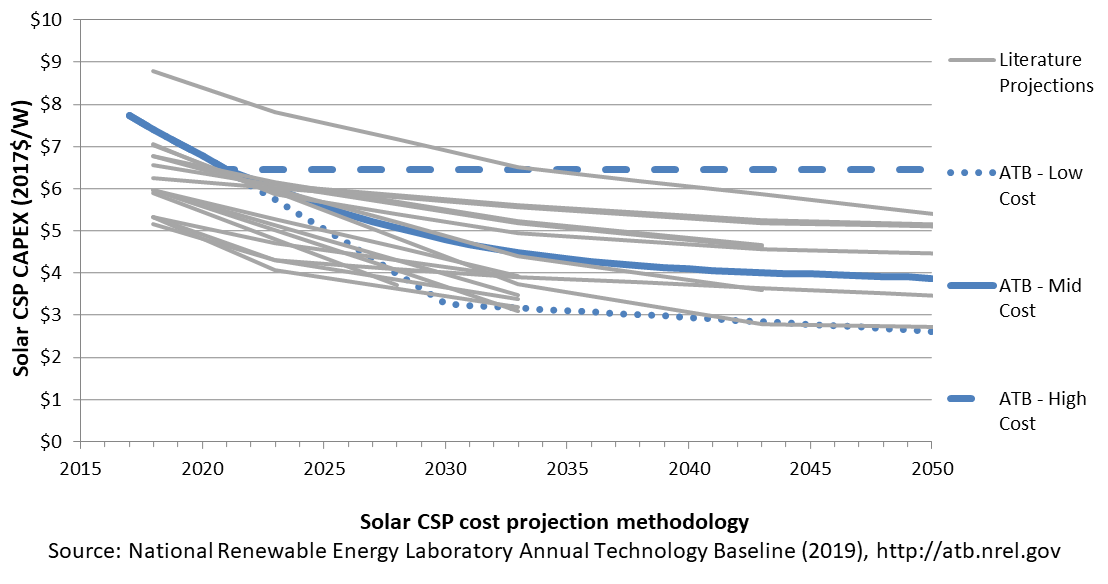Concentrating Solar Power
Plant Cost and Performance Projections Methodology
A range of literature projections is shown to illustrate the comparison with the ATB. When comparing the ATB projections with other projections, note that there are major differences in technology assumptions, radiation conditions, field sizes, storage configurations, and other factors. As shown in the chart, the ATB 2019 CSP Mid projection is in line with other recently analyzed projections from other organizations. The Low cost ATB projection is based on the lower bound of the literature sample, and on the Power to Change report (IRENA 2016).

Projections of future utility-scale CSP plant CAPEX and O&M are based on three different technology cost scenarios that were developed for scenario modeling as bounding levels:
- Constant Technology Cost Scenario
- Modeled as molten-salt (sodium nitrate/potassium nitrate, aka, solar salt) power tower with direct two-tank TES combined with a steam-Rankine power cycle running at 574°C and 41.2% gross efficiency in 2017
- Costs stay the same from the 2021 estimate through 2050, consistent with ATB renewable energy technologies
- Mid Technology Cost Scenario:
- Based on recently published literature projections and NREL judgment of U.S. costs for future CAPEX in 2025, 2030, 2040 and 2050 ((IRENA 2016), (Breyer et al. 2017), (Murphy et al. 2019), (Feldman et al. 2016), and (World Bank 2014)).
- It is anticipated that CSP costs could fall by approximately 25% from the ATB CSP 2021 costs of $6,450/kWe to approximately $4,800/kWe by 2030.
- CSP CAPEX is projected to fall from 2030 to 2050 to approximately $3,380/kWe.
- The cost reductions are anticipated due to gradual reductions in heliostat and power system cost due to greater deployment volume and learning assumed for 2021 and onwards based on current state of industry ((IRENA 2016), (Lilliestam et al. 2017)).
- CAPEX and O&M both drop by approximately 25% by 2030, relative to 2021 costs
- A further 30% overall CAPEX decrease is estimated from 2030 to 2050. All three components of the CSP CAPEX (the turbine, storage, and the solar field), decrease proportionately by approximately 30% from 2030 to 2050.
- Low Technology Cost Scenario:
- Significant reductions in heliostat and power system cost due to greater deployment volume and R&D are used for 2021 onwards; the plant was modeled as an advanced molten-salt power tower with direct two-tank TES combined with a power cycle running at 700°C and 55% gross efficiency in 2030 (Mehos et al. 2017).
- CAPEX and O&M decrease from likely cost reductions including new high-efficiency power cycles and low-cost heliostats.
- A further 20% overall CAPEX decrease is assumed from 2030 to 2050 based on potential deployment in the United States. The 20% decrease in overall CSP CAPEX is split over the three components: the turbine, storage, and the solar field. It can be expected that greater cost reductions could be achieved for the power block/turbine and the solar field than for the storage.
References
The following references are specific to this page; for all references in this ATB, see References.Breyer, C., Afanasyeva, S., Brakemeier, D., Engelhard, M., Giuliano, S., Puppe, M., … Moser, M. (2017). Assessment of Mid-Term Growth Assumptions and Learning Rates for Comparative Studies of CSP and Hybrid PV-Battery Power Plants. AIP Conference Proceedings, 1850, 160001-1-160001–160009. https://doi.org/10.1063/1.4984535
Feldman, D., Margolis, R., Denholm, P., & Stekli, J. (2016). Exploring the Potential Competitiveness of Utility-Scale Photovoltaics plus Batteries with Concentrating Solar Power, 2015-2030 (No. NREL/TP-6A20-66592). https://doi.org/10.2172/1321487
IRENA. (2016b). The Power to Change: Solar and Wind Cost Reduction Potential to 2025. Retrieved from International Renewable Energy Agency website: https://www.irena.org/DocumentDownloads/Publications/IRENA_Power_to_Change_2016.pdf
Lilliestam, J., Labordena, M., Patt, A., & Pfenninger, S. (2017). Empirically Observed Learning Rates for Concentrating Solar Power and their Responses to Regime Change. Nature Energy, 2(7), 17094. https://doi.org/10.1038/nenergy.2017.94
Mehos, M., Turchi, C., Vidal, J., Wagner, M., & Ma, Z. (2017). Concentrating Solar Power Gen3 Demonstration Roadmap (No. NREL/TP-5500-67464). https://doi.org/10.2172/1338899
Murphy, C., Sun, Y., Cole, W., Maclaurin, G., Turchi, C., & Mehos, M. (2019). The Potential Role of Concentrating Solar Power Within the Context of DOE's 2030 Solar Cost Targets (No. NREL/TP-6A20-71912). https://doi.org/10.2172/1491726
World Bank. (2014). Project Appraisal Document on a Proposed Loan in the Amount of EUR234.50 Million and US$80 Million (US$400 Million Equivalent) and a Proposed Loan from the Clean Technology Fund in the Amount of US$119 Million to the Moroccan Agency for Solar Energy with Guarantee from the Kingdom of Morocco for the Noor-Ouarzazate Concentrated Solar Power Plant Project (No. PAD1007). Retrieved from The World Bank website: http://documents.worldbank.org/curated/en/748641468279941398/pdf/PAD10070PAD0P100disclosed0120220140.pdf
